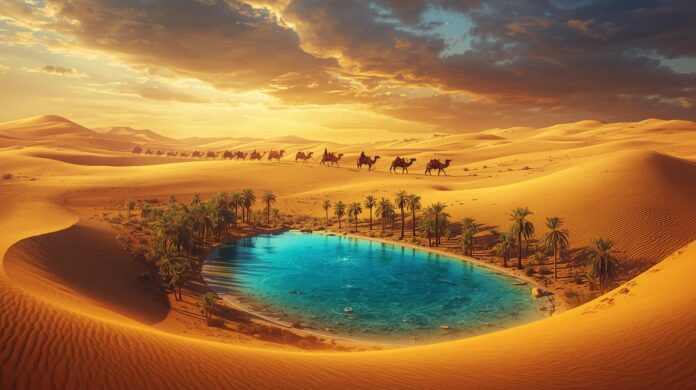Oasis is a fertile tract of land in the desert. It has a perennial source of water. Its area varies in size—1 hectare (2.5 acres) to more areas. Oasis has sandstone aquifers whose intake areas may be more than 800 kms away. Two-thirds of the total population of the Sahara Desert are living in oasis areas. Date palm is the main source of food in oasis. In its shade are grown citrus fruits, figs, peaches, apricots, vegetables, and cereals like wheat, barley, millet.
Oasis is the only source of water in deserts. What is desert? Sanskrit Lexicography defines Marubhumi (desert)—
“Yasyam Praninah jalabhabat mriyante saa marubhumi.”
Meaning—where the living creatures die due to scarcity of water, that place is called desert.
Oasis is a ray of hope of water and life. Some of the largest supplies of underground water exist under the Sahara Desert. There are about 90 major oases. Sahara is the largest desert on earth. Oasis in the Sahara and other parts of the world have become important stops along trade routes. Merchants and traders must stop at oasis to replenish food and water supplies. That means oasis controls the trade in the desert areas. Political, economic, and military are also aspects of oasis.
Al Hasa, Saudi Arabia, has become a good farming area. It produces dates, rice, corn, sheep, cattle, and eggs. This region is a rich oil field also. So Al Hasa Oasis is an important centre of international trade.
Rivers flow through some deserts, providing permanent sources of water. River Nile of Egypt is such an example. At 22,000 square kilometres, this is the largest oasis in the world. Nile is the lifeline of Egypt, and Magna Oasis is a great oasis in the Kharga and Dakhla areas in Egypt’s western desert—about 200 km west of the Nile Valley. This oasis was being used by the Romans. Rain is almost absent. Water comes from ancient groundwater and artesian sources.
In Old Kingdom Egypt, Kharga was on the oasis route connecting the Nile to interior deserts. Pharaonic temples and forts were built there. Romans named it Oasis Magna and built a series of forts along caravan paths to guard against desert raiders. This region produced and exported grain, cotton, dates, olive oil, wine, etc. Military units were stationed in Kharga to protect it in the 4th century A.D. Christian monasteries were also built at Kharga. The famous Bagawat Necropolis is Roman-built checkpoints at water sources. Roman forts were oriented to channel desert winds by their alignments. Oasis Magna played a key role in desert trade, military control, and religious life in ancient times.
So oasis is no less important in human society.
(The views expressed are the writer’s own.)

Radhakanta Seth is a Former Income tax officer in Sambalpur. He is a Freelance writer and his articles have been published in some Oriya dailies like Sambad, Samaj, Dharitri and English dailies like The Telegraph and in a sociological journal ‘Folklore’ published from Kolkata.
(Photo has collected from net )

